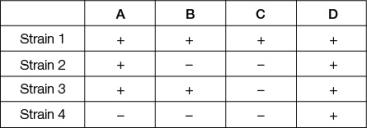Suppose that a certain wild-type bacteria can synthesize substance D, but various mutant strains cannot.We know that substance D is synthesized from substance X in a pathway that involves three intermediate substances (A, B, and C) , but we do not know the order of the steps in the pathway.The table shows four different mutant strains that have been tested for their ability to grow on the various substances.The "+" means that the strain can grow on that substance.The "‒" means that the strain cannot grow on that substance.  If another strain (say, strain 5) grows on substance B but does not grow on substance C, we can infer that it
If another strain (say, strain 5) grows on substance B but does not grow on substance C, we can infer that it
A) can grow on substance A.
B) cannot grow on substance A.
C) has a defect in the enzyme that converts substance B into substance C.
D) cannot grow on substance D.
E) has a defect in the enzyme that converts substance D into substance B.
Correct Answer:
Verified
Q1: In eukaryotic cells, translation occurs in the
Q2: The gene for the reverse transcriptase enzyme,
Q3: The transfer of information from DNA to
Q4: Which statement does not support Garrod's hypothesis
Q5: People with alkaptonuria are usually placed on
Q7: The adaptor between mRNA and a protein
Q8: The Beadle and Tatum experiment used X
Q9: Alkaptonuria results from a(n) _ of _.
A)
Q10: Which statement about the flow of genetic
Q11: Which statement about RNA is false?
A) Transfer
Unlock this Answer For Free Now!
View this answer and more for free by performing one of the following actions

Scan the QR code to install the App and get 2 free unlocks

Unlock quizzes for free by uploading documents